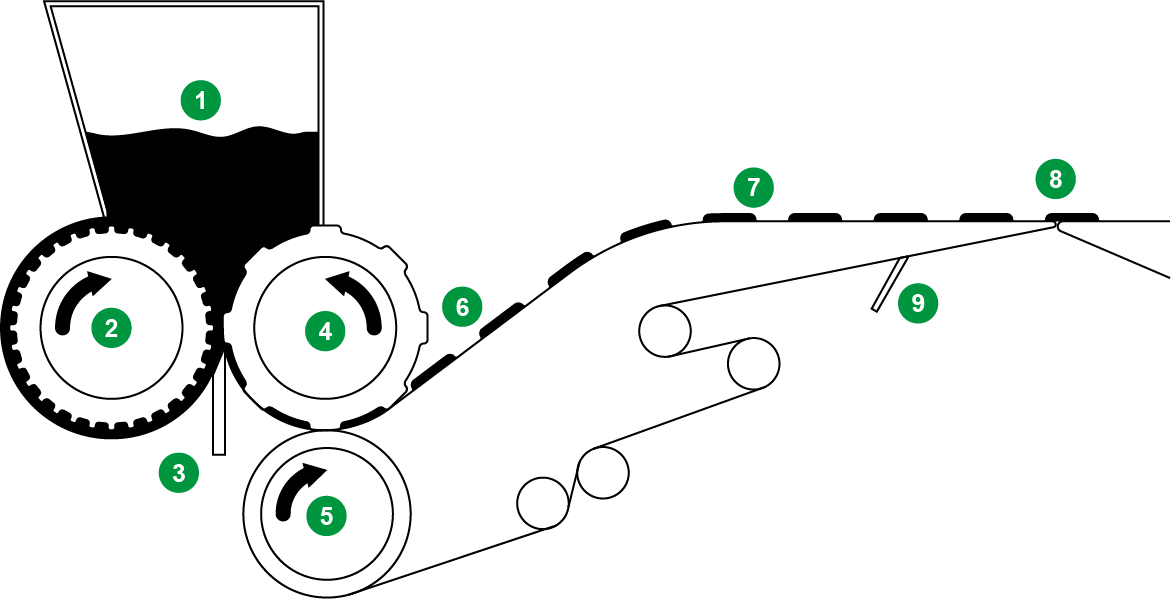How to solve extraction problems, short belt life and contamination issues in the rotary molding process

- Dough hopper
- Adjustable forcing roller
- Adjustable scraper
- Engraved molding roller
- Rubber-coated pressure roller (extraction roller)
- Rotary molder belt
- Formed dough pieces
- Nosebar for tight transfer
- Scraper
Advantages that minimize waste
In contrast to sheeting, gauging and cutting systems for biscuit manufacture, for the right type of doughs (not too fatty or too hard) rotary molding offers important advantages:
- No need to form and support a dough sheet
- Easy control of weight and shape
- No recycled scrap dough
- No gauging
In other words, rotary molding systems and belts deliver high output where accurate control of size, weight, thickness and texture are essential. As a result, rotary molding systems also reduce wastage and costs.
Challenges in the rotary molding process and how to crack them
While the advantages of rotary molding systems are clear, producing perfect biscuits depends on many elements, from the ingredients, to the recipe, to the dough and resting times, to the shape of the biscuits and their thickness, to the type of rotary molder and the environmental conditions in the factory.
The current trend is to increase the production capacity of biscuit production lines while keeping costs as low as possible. Line widths and speeds are increasing, creating additional challenges for operators. The drive to lower costs leads to the reduction or elimination of stock in the warehouse, while the wide choice of biscuits required by the market obliges producers to change formats more often, producing on the basis of orders received. This makes it essential to have accurate and careful maintenance of the lines, and the use of reliable and functional belts in all operating conditions.
And as things don’t always go smoothly, biscuit manufacturers often contact me to ask for advice. The three most common questions we get are:
- How can I extract the biscuits easily from the engraved roller leaving as little tail as possible?
- How can I get the most out of the rotary molder belt and extend its life?
- How can I avoid fraying of the belt, which can cause contamination?
Let’s have a look at these challenges and how to address them.
1. Extraction problems
Extraction problems can have several causes, from the improper adjustment of roller pressure, to different speeds between the rollers and the belt, to inadequate maintenance of the rotary molder. Our bakery experts are always glad to help identify the exact source of the difficulties and help eliminate this.
Often, however, extraction problems are caused by using the wrong belt materials for the dough. Natural fibers such as cotton are standard for rotary molder belts, due to their excellent extraction behavior based on the absorption of fat and moisture from the biscuit dough. But because cotton yarn has low resistance to abrasion and a tendency to stretch, it can be necessary to use other fibres as well, such as linen, polyamide or polyester, to obtain the ideal belt for the application.
We also find that belt joints on the extraction web can be the cause of uneven extraction. In these cases, we advise installing a belt that’s woven endless to eliminate the problem and ensure uniform extraction.
The choice of the weave pattern of the belt is also very important, as extraction is affected by the anchoring of the biscuit base on the weave of the belt fabric. Plain, cross twill or herringbone? We can advise on the best weave pattern for each dough.
2. Short belt lifetime
In our experience, belt elongation and edge fraying are the two main causes of short life span and the need for frequent belt replacement.
Elongation of the belt, in addition to creating possible tracking problems, causes narrowing of the width of the belt. If the belt becomes narrower than the engraved roll, it is no longer possible to produce biscuits. The causes of excessive elongation can be various, from the wrong choice of belt type to incorrect use of the belt. To combat elongation, one solution we advise is to loosen the tension of the belt after production, so that the belt recovers some of its natural elongation.
The linen fibers providing lateral stability and therefore good trackability, while the TPU impregnation not only ensures dimensional stability, but also preserves the underside of the belt, which must work with knife edges of small diameter.
3. Fraying of the belt
The fraying of belt edges is one of the main causes of product contamination, and therefore of belt replacement. One solution is to add polyamide fibers to the cotton in the belt, which increase the belt’s resistance to the wear caused by the action of metal scrapers or the pressure of the engraved roller. Another solution is to install belts with polyamide selvedge edges, which provide durable protection against edge wear, thus preventing fraying and protecting against product contamination and the waste and expense this causes.
Expert technical support
Are you satisfied that your biscuit production line is operating at maximum efficiency and output? Stefano Tondini and our colleagues in our expert biscuit application team will be glad to discuss your retrofit needs, cleaning and maintenance procedures, and the start-up of your new installation. Please contact us or visit the Habasit website for more information on rotary molder belts.